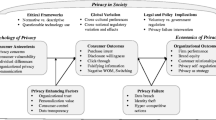Abstract
In their article, Cheng and Monroe provide a historical perspective on behavioral research in pricing. Their consolidation of evidence spanning four decades of research on pricing is testimony to the richness that can result from the convergence of different perspectives and fields on a common set of phenomena. Although the article is framed in terms of concepts that have emerged from substantive concerns, there might be some utility in thinking about the issues in behavioral price research within the framework of an information processing model. Such a model allows one to localize different effects at various stages of processing and helps to raise additional issues to be investigated.
Similar content being viewed by others
References
Adaval, R. (1996). The role of affective (mood) states in perceptions of quality, sacrifice and value, doctoral dissertation. Urbana-Champaign: Graduate College, University of Illinois.
Adaval, R., & Monroe, K. B. (2002). Automatic construction and use of contextual information for product and price evaluations. Journal of Consumer Research, 28, 572–588.
Adaval, R. & Wyer, R. S. (2011). Conscious and nonconscious comparisons with price anchors: effects on willingness to pay for related and unrelated products. Journal of Marketing Research, 48(2), 355–365.
Blankenship, K. L., Wegener, D. T., Petty, R. E., Detweiler-Bedell, B. T., & Macy, C. L. (2008). Elaboration and consequences of anchored estimates: an attitudinal perspective on numerical anchoring. Journal of Experimental Social Psychology, 44(6), 1465–1476.
Cheng, L., & Monroe K. B. (2013). An appraisal of behavioral price research (part I): price as a physical stimulus. AMS Review, current issue.
Coulter, K. S., & Coulter, R. A. (2010). Small sounds, big deals: phonetic symbolism effects in pricing. Journal of Consumer Research, 37(2), 315–328.
Epley, N., & Gilovich, T. (2006). The anchoring and adjustment heuristic: why the adjustments are insufficient. Psychological Science, 17(4), 311–318.
Helson, H. (1964). Adaptation-level theory. New York: Harper & Row.
Hsee, C. K., & Rottenstreich, Y. (2004). Music, pandas and muggers: on the affective psychology of value. Journal of Experimental Psychology. General, 133, 23–30.
Hsee, C. K., Rottenstreich, Y., Yang, Y., Gu, Y., & Chen, J. (2009). Specification seeking: how product specifications influence consumer preferences. Journal of Consumer Research, 35(6), 952–966.
Krishna, A., Wagner, M., Yoon, C., & Adaval, R. (2006). Effects of extreme-priced products on consumer reservation prices. Journal of Consumer Psychology, 16, 176–190.
Monga, A., & Bagchi, R. (2012). Years, Months, and Days versus 1, 12, and 365: the influence of units versus numbers. Journal of Consumer Research, 39(1), 185–198.
Monroe, K. B. (1968). A method for determining product line prices with end-price constraints. Unpublished doctoral dissertation, Graduate College, University of Illinois: Urbana-Champaign.
Monroe, K. B. (1971a). The information content of prices: A preliminary model for estimating buyer response. Management Science, 17, B-519–B-532.
Monroe, K. B. (1971b). Measuring price thresholds by psychophysics and latitudes of acceptance. Journal of Marketing Research, 8, 460–464.
Monroe, K. B. (1973). Buyers’ subjective perceptions of price. Journal of Marketing Research, 10(February), 70–80.
Monroe, K. B. (2003). Pricing: Making profitable decisions (3rd ed.). New York: McGraw-Hill Book Co.
Mussweiler, T., & Strack, F. (1999). Hypothesis-consistent testing and semantic priming in the anchoring paradigm: a selective accessibility model. Journal of Experimental Social Psychology, 35, 136–164.
Nunes, J. C., & Boatwright, P. (2004). Incidental prices and their effect on willingness to pay. Journal of Marketing Research, 41, 457–466.
Oppenheimer, D. M., LeBoeuf, R. A., & Brewer, N. T. (2008). Anchors aweigh: a demonstration of cross-modality anchoring and magnitude priming. Cognition, 106(1), 13–26.
Ostrom, T. M., & Upshaw, H. S. (1968). Psychological perspective and attitude change. In A. G. Greenwald, T. T. Brock, & T. M. Ostrom (Eds.), Psychological foundations of attitudes (pp. 217–242). New York: Academic.
Parducci, A. (1965). Category judgment: a range-frequency model. Psychological Review, 72, 407–418.
Quattrone G. A., Lawrence, C. P., Finkel, S. E., & Andrus, D. C. (1984). Explorations in anchoring: the effects of prior range, anchor extremity, and suggestive hints. Unpublished manuscript, Stanford University
Raghubir, P., & Srivastava, J. (2002). Effect of face value on product valuation in foreign currencies. Journal of Consumer Research, 29, 335–347.
Shafir, E. B., Diamond, P., & Tversky, A. (1997). Money illusion. Quarterly Journal of Economics, 112, 341–374.
Shen, L., & Urminsky, O. (2013). Making sense of nonsense: the visual salience of units determines sensitivity to magnitude. Psychological Science. Published online January 29, 2013, doi:10.1177/0956797612451470.
Strack, F., & Mussweiler, T. (1997). Explaining the enigmatic anchoring effect: mechanisms of selective accessibility. Journal of Personality and Social Psychology, 73(3), 437–446.
Tversky, A., & Kahneman, D. (1974). Judgment under uncertainty: heuristics and biases. Science, 185, 1124–1130.
Walsh, V. (2003). A theory of magnitude: common cortical metrics of time, space and quantity. Trends in Cognitive Sciences, 7(11), 483–488.
Wertenbroch, K., Soman, D., & Chattopadhyay, A. (2007). On the perceived value of money: the reference dependence of currency numerosity effects. Journal of Consumer Research, 34, 1–10.
Wyer, R. S., & Adaval R. (2008). Social psychology and consumer psychology: An unexplored interface. In The social psychology of consumer behavior (Editor: Wänke, M., University of Basel, Switzerland). Frontiers of Social Psychology (Series Editors: Kruglanski A. W & Forgas, J. P). New York: Psychology Press.
Zeithaml, V. A. (1988). Consumer perceptions of price, quality, and value: a means-end model and synthesis of evidence. Journal of Marketing, 52, 2–22.
Zhang, Y. C., & Schwarz, N. (2012). How and why 1 year differs from 365 days: a conversational logic analysis of inferences from the granularity of quantitative expressions. Journal of Consumer Research, 39(2), 248–259.
Acknowledgments
The writing of this article was supported by Grant No. GRF640011 from the Research Grants Council of Hong Kong.
Author information
Authors and Affiliations
Corresponding author
Rights and permissions
About this article
Cite this article
Adaval, R. The utility of an information processing approach for behavioral price research. AMS Rev 3, 130–134 (2013). https://doi.org/10.1007/s13162-013-0045-x
Received:
Accepted:
Published:
Issue Date:
DOI: https://doi.org/10.1007/s13162-013-0045-x




